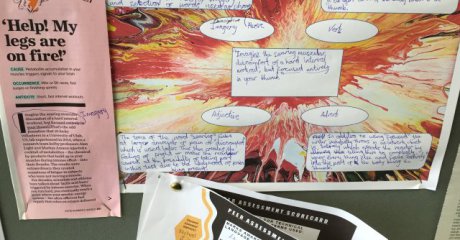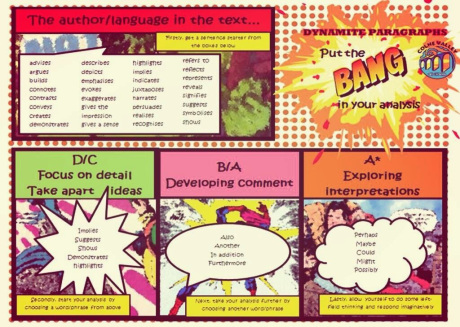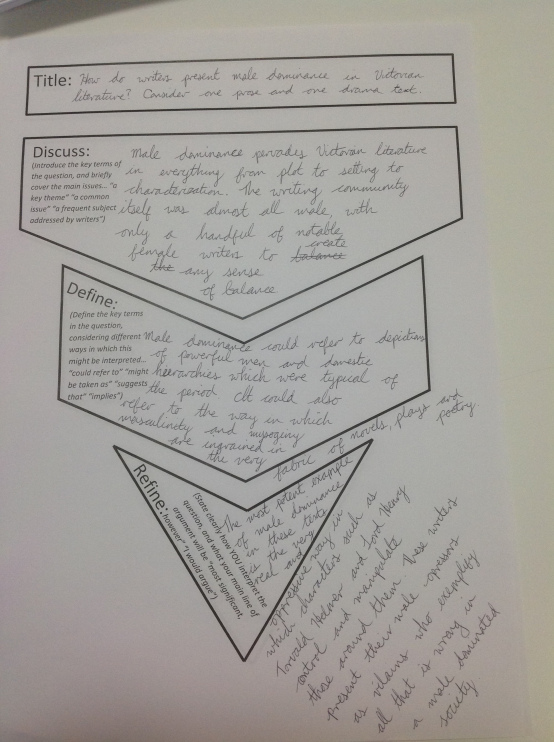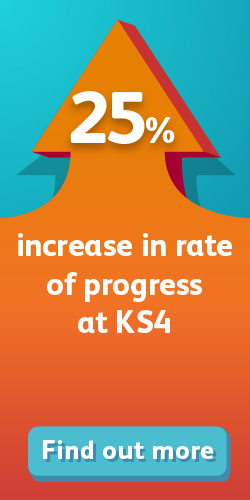
 This article is authored by Jennifer Webb, Head of English at Appleton Academy in Bradford, West Yorkshire. It was originally posted on her own blog.
This article is authored by Jennifer Webb, Head of English at Appleton Academy in Bradford, West Yorkshire. It was originally posted on her own blog.
The creativity and generosity of the online teaching community never ceases to amaze me. I have spent a couple of weeks collating resources for my department from my Twitter back catalogue, and was blown away by how long the list was.
Years of communication with fellow educators has given me a huge collection of ideas and resources, some of which I use regularly, and some which I had forgotten about entirely.
In an attempt to bring some order to the chaos, I have started with some reading and analysis resources. All of these resources were created by teachers, and shared online – you can see the creators’ details below in case you want to follow anything up with these very talented people.
Though I’ve collected them here for English resources, most can be very easily adapted to other subjects and disciplines.
For ease of use, I’ve organised the post into four groups:
- Analysis templates and techniques
- Understanding or revising texts
- Explaining and exploring structure
- Expression.
Analysis templates and techniques
The first few of these are based around using hexagons to scaffold writing, planning and ideas. There are tons of hexagon-based resources out there – these are a few which I know work really well…
1. Concentric Hexagons from @JamieClark85
These can be used to revise or explore characters, themes etc in a text. I ask students to write their topic (character, theme, idea) in the middle hexagon, then the next level out is for quotations, leading to a level of analysis, and a level of wider exploration (context/wider reading/critical viewpoints/alternative interpretations etc.)
This has the potential to work for all age groups and for a lot of disciplines. My Y13 Literature students love it – I break each hexagon into a different assessment objective.
Quality example of Connectagons. Students analyse characters & themes then position shapes to make links (in orange) pic.twitter.com/89MBbslNkt
— Jamie Clark (@JamieClark85) October 13, 2015
2. Visual Hexagons from @misscs_teach
Using images to prompt students to explore or revise a topic without simply looking at a text – this example is from history, but could work brilliantly as a range of images from a poem or novel…
Y9 using visual hexagons and their O.K./research to explain recruitment in 1914 #teaching #historyteacher #ukedchat pic.twitter.com/O9ICYEFNCS
— misscs_teach (@misscs_teach) February 9, 2016
3. Linking Hexagons by @LessonToolbox and @Jivespin – shared by @OLewis_coaching
This is a fab key word linking activity which would work in ANY subject. Students write key words in the hexagons (could also work with quotations for English), then in the boxes at the bottom they explain how each hexagon links to the others.
Key word links for revision & evidencing understanding! great resource by @LessonToolbox ??#OSPhysics #links pic.twitter.com/6K569jokYe
— Olly Lewis (@OLewis_coaching) May 26, 2016
4. Quotation Explosion
There have been dozens of these resources flying around Twitter for a couple of years, ranging from the functional to the very beautiful. At it’s core, though, the quotation explosion is about detailed exploration of language, encouraging students to literally take a statement or image apart.
The version we have been using in our department is here: Explode a Quotation.
A great example I saw recently from @cazzwebbo can be found on her excellent blog.

5. 7 deadly sins from @LPuds
MORE hexagons! This is a great way to link abstract ideas to a text. Works brilliantly with An Inspector Calls, but could work with a huge range of literature texts…
Exploring links between ‘An Inspector Calls’ and the 7 deadly sins with top set year 10 #hexagons #engagingstudents pic.twitter.com/DEaDSaxznQ
— Laura Pudney (@LPuds) May 24, 2016
6. Character Outlines

There are tons of variations on this resource, too. It is basically a nice, visual way to work on characterisation. Give students a blank body outline and get them to make notes inside and outside the shape. I get my students to put character traits inside, and quotations to support it outside, but this has tons of other possibilities.
One really great variation of this idea is one I saw recently from @HeadofEnglish:
Y9 Of Mice revision. Character cut outs 2.0: using mini-me chains to collect ideas for each character. #engchatuk pic.twitter.com/2r4RPDQckh
— Caroline Spalding (@HeadofEnglish) May 24, 2016
There are tons of other brilliant ideas on Caroline’s blog.
7. Linking Extracts from @missfordenglish
A fab group activity where students annotate and make links between extended passages and extracts from texts.
Year 9 – analysing texts and drawing out comparisons. pic.twitter.com/JnQ9XeMppy
— Lisa Marie Ford (@missfordenglish) April 19, 2016
8. Paragraphs exploration map
This is one of my resources from a while ago and, while it uses the dreaded PEEEE(ad infinitum) structure which appears to have gone out of vogue, it is a useful way of looking at paragraphing and textual analysis through the metaphor of exploration and zooming in and out… the resource for the mat is here (front and back pages):
9. Peephole Analyser
I designed this resource as a way of scaffolding planning and writing to include all of the required elements in the AOs for A Level, but it can also act as a way to read, interrogate or peer assess a document. The example here is an ‘analyser’ for the AQA Literature A legacy spec victorian paper:


You make the resource by leaving an A4 sized hole in the middle of an A3 piece of paper, and framing the hole with hints, tips, key words, reminders etc for whatever the intended piece of writing is. This works well as a frame for peer and self-assessment because students can look at what the requirements are and produce very detailed feedback.
It could also work well as a generic resource for looking for literary elements in extracts or unseen poetry. The document pictured above can be found here. Feel free to use/edit/discard!
10. Dynamite Paragraphs – original idea from @Murphieface, visual designed by @JamieClark85
Read the blog from @Murphieface.
Here is the gorgeous adaptation of the idea from @JamieClark85:

11. Character Heads from @siancarter1
This is a totally wacky but brilliant idea! @siancarter1 managed to source some mannequin heads, and did this lovely thing for The Strange Case of Dr Jekyll & Mr Hyde revision…
Jekyll and Hyde heads are coming along very nicely! Really proud of my Y10s #ukedchat #engchatuk pic.twitter.com/VilgLBIQpT
— Siân Cumming (@siancarter1) November 16, 2015
Works brilliantly for the internal struggle and duality in this novel, but could be adapted for many other texts and characters.
12. Connotation Circles from @MissJLud
Magic Circles (or connotation circles) were designed to encourage students to write analytical answers and think of multiple layers of meaning and to help improve their analysis of sentences or keywords. They can be used by all year groups and in a variety of ways. They are a scaffolding tool which can be removed once students know how to add multiple layers of meaning to their analysis.
Firstly, you must ensure students know what question they are being asked. They must think about the answer to that question (their point) and write it in the top box. From here, students identify the key quotation they would like to analyse to answer the question. To encourage students to keep the quotation short, the box is quite small!
The middle of the circle says ‘keyword’ but more often than not I tell students to put the whole quotation in. This is important especially with difficult quotations (where it’s hard to find a keyword) for example a quotation from Shakespeare or Chaucer as they also need to remember to explain what they mean before analysing.
Once they have filled in the point and evidence sections, they can begin to think of words to use in their analysis. With a keyword, this is quite simple and students can think of a connotation that is relevant to the question (usually you need to stress this point!) From then on, each box is filled in with a further connotation of the previous word.
To make sure they are relevant and developed multiple layers of meaning (rather than just synonyms) it is important that the connotation is of the previous word and not just of the key word in the middle. Hence why the arrows flow as they do! For a difficult quotation, it may be necessary to look at it as a whole and students can then move on from that point.
For the last step, students must think of a link between the final connotation and their overall point. This ensures they are answering the question.
Once the whole circle is complete, students can use a range of linking sentences to fit in their ideas. You can use a range of active verbs to encourage students to analyse in detail. It is very useful to model this to students first of all. There are a range of examples below from Year 7 and Year 10 students where you can see how they have used the connotation circles in a few different ways.
Common issues:
- Students don’t know what connotation means and this needs explaining.
- Students pick connotations that are not relevant to the question. Eg “Red – Man United”
- Making the link to the point can be hard/impossible depending on the quotation and question – you and the student can decide whether or not to leave this out.
- Students don’t know how to write up their paragraph without modelling.
Link to Publisher and PPT documents from @MissJLud.
Understanding and Revising Texts
13. Mapping the plot from @MrMoonUnity
This resource enables students to make notes on narrative events, ideas, characters etc, using images from the text. The best part is that, by so explicitly placing their work in the text’s setting, students are forced to consider place, character journeys, and perhaps notice structural elements of the text they might not have seen before.
Today, @UnityBlackpool pupils mapped key narrative events in #OfMiceAndMen during their independent reading session. pic.twitter.com/LoJ8Vtw8fY
— Mr Moon (@MrMoonUnity) May 26, 2016
@MrMoonUnity has very kindly shared the original document – feel free to make use of this version.
14. 5 A Day Starters from @TLPMsF
This idea is explained brilliantly on Rebecca’s excellent blog. She has also very kindly shared a link to the resources in her GoogleDrive!
Here’s a post about my KS4 5-a-Day Starters with a link to GoogleDrive folder: https://t.co/0AzKfbINhE #teamenglish #engchatuk #ukedchat
— Rebecca Foster (@TLPMsF) May 26, 2016
15. Visual Timelines from @sarahcnokes
A lovely, simple idea, which could be adapted to tons of subjects. Students use both images and text to explain processes or plot lines. This is an example from Geography, but could easily be adapted to explore events in plots, character journeys and arcs in literature. The use of images could be literal or figurative and allow students to map out how imagery is used throughout a text.
Gave visual time lines a go today. Needs work to improve effectiveness but yr11 loved them! #geovise pic.twitter.com/d3VAmDfKcM
— Sarah (@sarahcnokes) April 26, 2016
16. Images
Using pictures as stimuli for discussion, promoting recall, making abstract links or just for talking literally about imagery, is part of our English teaching bread and butter. All the same, the simplest ideas are often the best.
This is a nice example I saw in a tweet from @kathydarlison85:
@CrazyAboutBooks study the images and make links to OMAM: quotations, language, context, intentions ??? pic.twitter.com/KmIbKyeFCq
— KathyHowell (@kathydarlison85) May 16, 2016
I used to have a tissue box which I’d covered in pictures (angels, clouds, a monkey, a woman’s face, a bridge and a tree). Students would throw the box around and have to link the text or a quotation to whichever picture was face-up.
17. Mood Boards
A way of creatively exploring a text, mood boards allow students to bring their own ideas and interpretations to a piece of work in a truly multi-sensory way.
I’ve had students produce boards with pieces of jewellery, broken glass, fabrics, evocative scents and even sound effects! You can find a post on mood boards with some good examples on my blog.
This is a very recent example of a beautiful hand drawn board from one of our A-level Literature students, based on Stanley in A Streetcar Named Desire…

18. Revision Clock from @teachgeogblog
This is possibly my department’s favourite resource this year. We have used and adapted it across the age range, and students have loved it! The basis premise is that you use the clock in the centre to represent an hour of lesson time, and then you chunk up the hour into segments of the page for separate revision topics (or focuses within a topic).
Need to fit a whole topic into an hour? Pupils struggling to revise? Introduce the #revisionclock one hour one topic pic.twitter.com/jRXHoGoYBL
— TEACH GEOG BLOG (@teachgeogblog) October 15, 2015
I’ve used it very successfully with both HA and LA groups, and found that students are liberated by the limitation of 10 minute or 6 minute blocks to complete something.
My Y11 top set recently did this as a competition to see who could get the most information down in a hour without any notes or revision material in sight – they had to write down as many facts and quotations as they could remember about the characters in Of Mice and Men. They were really shocked by how much they actually knew!
Check out @teachgeogblog’s other resources.
Exploring Structure
Structure can be a nightmare to teach, particularly at GCSE where a lot of the really technical A-level stuff is a bit unnecessary. Here are a couple of resources to tackle this…
19. Approaching Structure from @DAP206
Great blog post from Danielle Perkins: What is Structure, Miss?
This post talks about using abstract concepts and images to teach structure.
20. Structure Questions from @atharby
A really excellent list of questions which can help us to unveil and dig deeper into the illusive world of structure.
2nd draft of structure questions doc. Thanks Twitter for the help. Any other questions? https://t.co/Q1hDQKbukf pic.twitter.com/A1JuoFgOQi
— Andy Tharby (@atharby) May 17, 2016
Expression
This can be a difficult thing to teach because we are all keen to give students sentence structures, vocabulary and writing structures without producing a load of PEE-ing robots who don’t have individual analytical writing styles!
I believe the trick is to give them some sound principles, as many models as you can get your hands on, and lots and lots of options for new vocab, phrases and structures as you can.
21. Academic Expression from @TheSickScholar
This is a fabulous seminar written by my good friend, Leslie Rowland. Read her PowerPoint and handout.
22. Advanced Vocabulary from @RealGeoffBarton
I’ve used this list with students for ages, and it always serves to boost confidence and creativity in their writing. Read Geoff’s post.
23. Solar System essay planning
This is one of mine. I’ve used it primarily with A Level groups, but it has been adapted by other teachers for use across the whole range. Read the post.


24. Discuss, Define, Refine
Something I stumbled across online (can’t remember where), when I was a PGCE student, this system is brilliant for structuring introductions. I’ve used it for GCSE and A Level. Find out more.

25. Words to describe writers’ choices – shared by @kathydarlison85
There are lots of these lists floating around Twitter, and they can be really useful for giving students the language they need to express the most interesting and nuanced ideas. This is a nice one:
@CrazyAboutBooks year 11 use these words when discussing writers’ choices ??? pic.twitter.com/n0ND8aG4K7
— KathyHowell (@kathydarlison85) May 16, 2016
26. Writing to Show a Viewpoint from @HeadofEnglish
A fab range of phrases and sentence starters for students to help them to express an opinion…
Here are all my ‘writing to show a viewpoint’ sentence starters in case you want to nick them ☺️ #engchatuk pic.twitter.com/LkdF0fATkn
— Caroline Spalding (@HeadofEnglish) March 16, 2016
27. Analytical Vocabulary Mat
This is one of my resources which we have in our classrooms at Appleton. It has analytical vocabulary grouped for purpose, with a glossary and exemplar on the back. Feel free to use/adapt as you like!
Obviously, this is not an exhaustive list! I would like to keep it relevant by adding more to this post as more things come up. Please let me know if you have something you use regularly for reading and analysis which you think I should include up here and I’ll happily edit the post and credit you.
Read Jennifer’s previous blog, The dyslexic English teacher.
Appleton Academy is part of the SSAT network – find out more about membership.





